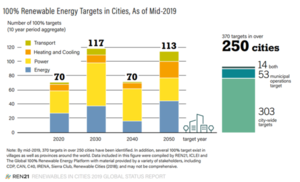“It might come as a surprise to some, but it is a pattern that we now find everywhere in the world: Cities are driving the transition towards renewable energy. They understand that renewables mean less lung and heart diseases, more local jobs and relief for the municipal budget,” says Rana Adib, REN21’s Executive Secretary, at the presentation of their first Renewables in Cities 2019 Global Status Report (REC-GSR) in Paris. “If cities alone were to decide, today’s climate and energy politics would look totally different.”
“Fossil fuel centered economies make it difficult for national governments to put climate concerns front and center, with the result that globally we are not on track to meet the Paris Agreement. This truth is hard to face. The Emissions Gap Report 2019 that our partner UNEP releases today shows the harsh reality: countries collectively fail to stop growth in global greenhouse gas emissions. The gap between targets and reality is only growing. Deeper and faster cuts are required now, and cities can take climate action into their own hands,” says Rana Adib.
By November 2019, almost 1,200 jurisdictions and local governments in 23 countries had declared a state of climate emergency. Almost 10,000 have already adopted carbon emission reduction targets, many of which linked to renewable energy, notes the newly released report.
First ever global stock-taking of cities’ efforts to transition to renewable energy
Many countries still expect that the implementation of 100% renewable energy systems will take several decades. Yet, there are plenty of cities in the world that already today source 100% of their electricity from renewables. Now, they are taking steps to expand their ambitions to get rid of fossil fuels in heating, cooling, transport and industry.
The report shows that more and more cities in Europe take the energy supply back into their own hands by re-municipalising energy companies or forming new ones. Barcelona Energía, recently formed to supply locally produced renewable energy to the city’s inhabitants and municipal facilities, is just one example. In 2000, Barcelona was also one of the first European cities to require all new and renovated buildings to use solar energy to supply a minimum of 60% of a building’s running hot water needs. The next project in line is a solar cooling network which is expected to start operating by the end of 2019.
Renewables could save millions from premature death
“An important message from the report is that many cities understand that they are directly suffering from the burning of fossil fuels. Shifting to efficient and renewable energy systems is the only way out,” notes Adib.
One of the most powerful motivations is air pollution. Particles and other air pollutants from fossil fuels literally asphyxiate cities. They barely measure a fraction of the diameter of a human hair, but according to studies by the World Health Organisation, their presence above urban skies is responsible for millions of premature deaths and costs billions. Health damages by road traffic alone cost the European Union around 62 billion euros a year.
Mr. Ban Ki-Moon, former UN Secretary General and Chair of Korea’s National Council on Climate and Air Quality underlines the link between burning of fossil fuel and citizens’ health. “Unsustainable and reckless consumption of energy has led to concerning levels of air pollution, making it the fourth-largest threat to human health and the single biggest environmental health risk that we face today. Against this background, transition to a cleaner and more sustainable energy model is no longer a choice but a must. Cities can spearhead progress in combating air pollution, by implementing creative policies and incubating innovative ideas, like what the Seoul Metropolitan Government is doing. We have the necessary means to pursue energy transition. All we need is the political and institutional will to make the transition into reality.”

Like Seoul, Barcelona, Berlin, Copenhagen, Heidelberg, Lisbon, London, Madrid, Paris, Rotterdam, Stockholm and Warsaw have all pledged to set new air quality standards that meet or exceed existing national targets within two years. When signing the declaration in October, Copenhagen’s Mayor Frank Jensen commented: “Air pollution is a global problem, but it has a local solution. Copenhagen wants to be the world’s first climate-neutral capital by 2025. This year, we have put 400 electric buses on the streets and by next year ferries should go electric, too. We want that our citizens can take a deep breath at any time of the year without fearing for their health.”
Many cities in developing countries are leaders in renewable expansion
“We can say that many benefits from renewables are the same all over the world,” explains Adib. “But there are also differences. For cities in the developing world, renewable energy is the only way to expand energy access to all inhabitants, particularly those living in urban slums and informal settlements and in suburban and peri-urban areas.”
Cape Town has the highest electrification rate in South Africa but thousands of households are in areas which are un-electrifiable because the land is illegally occupied or situated in a flood prone or restricted area. Poverty often causes households to not use electricity for part of the month. “While efforts to deliver housing are ongoing there is significant informality. Open flame technologies like candles and paraffin stoves are used. Devastating shack fires occur periodically causing deaths, injuries and displacement. Solar home systems are a safe and affordable alternative”, explains Dan Plato, Mayor of Cape Town.

Executive Director of the United Nations Environment Programme, Inger Andersen, believes that “by avoiding resource depletion and pollution, and creating jobs, renewable energy is a common-sense engine of social and economic development. As our cities expand, those built on a strong renewable energy base will thrive.”
Renewables make cities resilient
Data in the report reveals that increased prosperity and living standards in cities cause a sheer insatiable hunger for energy. REN21´s report shows that 70% of all cities are already affected by the impact of climate change today. Says Adib: “If cities don't do something about the way they produce and use energy, they are going to wreak their own destruction. It’s that simple and they know it. And with more than one billion people worldwide living in urban slums and informal settlements, the poorest will be the hardest hit. Even in Europe, tropical storms will become more frequent. We got a taste of it when storm Leslie hit northern and central Portugal with wind speeds of over 100 km/h and brought heavy rainfall in Spain and France last year.”
Keeping the energy infrastructure working, once the flood or storm arrives, is essential to secure continued operation of rescue services, hospitals and information systems. Businesses and industry invest in renewable energy to avoid disruptions. Cities adopt energy systems based on distributed renewable generation because they are more flexible and resilient to those central shocks which are becoming more frequent with climate change, underlines the report.
Participation at the local level makes the difference
“An advantage of renewable energy is that it gives citizens a role in shaping the infrastructure,” says Adib. “Our report shows that in recent years, the number of community energy projects using renewable sources has surged, confirming that democracy is just as important as a driver for the energy transition as climate change.” Denmark, Germany and the UK are at the forefront of this development. Yet, such projects begin to emerge also in other parts of the world including Thailand, Japan, and Canada, the report notes.

“Cities can actively drive the fight against climate change at national and global level. They are able to tap into opportunities that other levels of government do not have, including a more direct relationship with local citizens and businesses,” notes Germany’s Minister for Environment, Nature Conservation and Nuclear Safety, Svenja Schulze. “Citizen engagement and public pressure have raised cities’ level of ambition on renewables in many places around the world, reaping economic, social and environmental benefits.”
“Yet, it is important to emphasise that even the world’s largest cities with the most decision-making structure cannot replace national governments and their responsibility in fulfilling their commitments under the Paris Agreement. As the climate crisis unfolds, no one can hide,” Adib, concludes.The Renewables in Cities 2019 Global Status Report is the first in what is to become an annual stock-taking of the world’s cities transition to renewable energy. It aims to make data available, more standardised, easier to evaluate and compare. “We expect that it will be an important tool to document developments and consequences of the transition to renewable energy worldwide,” says Adib. (HCN)







